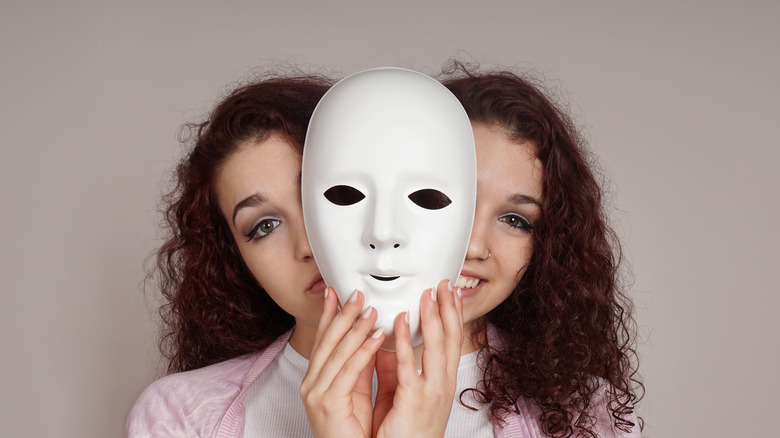Selena Gomez's Bipolar Disorder Diagnosis Explained
Selena Gomez has long been a household name. You may know her from the Disney Channel or through her music career. She found fame at a young age and has been in the public eye ever since, through health woes and heartache, hit singles and success. She opened up to Elle in August about the effect that fame had on her life as well as the way her mental health has affected her, both publicly and privately.
Gomez has never shied away from talking about her anxiety and depression. But in 2020 she announced that two years before she had been diagnosed with bipolar disorder. A 2019 study published in the World Journal of Psychiatry revealed that at least 50% of people with bipolar disorder also experience anxiety while depression is a symptom of bipolar disorder. Understanding the connection can make a world of difference in a patient's life. As Gomez put it, receiving her bipolar diagnosis removed a "huge weight" from her and finally gave her a sense of understanding.
Unfortunately, the condition is still widely misunderstood. Phrases like "so bipolar" are common in day-to-day speech, though few people understand the details of what it means to be bipolar.
Bipolar disorder symptoms
Mental Health America estimates that one in 40 American adults, or 2.5%, live with bipolar disorder while 1% of teenagers experience symptoms. It is the sixth leading cause of global disability and tends to occur in tandem with addiction. This may be because the average length of time between the onset of symptoms and an official diagnosis is roughly 10 years.
For those who view bipolar disorder as little more than "mood swings," this delay might not seem so terrible. But bipolar disorder is much more than an issue of mood swings. According to the National Institute of Mental Health, bipolar disorder was previously known as manic depression. And while mood swings are part of the disorder, their impact reaches much farther.
When someone with bipolar disorder is in an "up" or manic phase, they may feel like they are substantially smarter, more capable, or more important than other people. They are prone to rash, risk-taking behaviors that can include substance use and unprotected sex. Their thoughts often race and they may feel like they can do everything at once. At the same time, they will often forget to eat and will not feel the urge to sleep. In a "down" or depressive phase, all of these symptoms reverse. They may sleep too much and struggle to stay awake while overeating and lacking the ability to feel pleasure. They may feel slow or sluggish as well as unimportant. They may also entertain suicidal ideations.
Types of bipolar disorder
The National Institute of Mental Health explains that there are three types of bipolar disorder, as well as a fourth classification for people who may experience bipolar symptoms in bursts or who have only been experiencing them for a short while. This fourth classification is known as "other specified and unspecified bipolar and related disorders."
People who have experienced relatively mild symptoms for at least two years are often diagnosed with cyclothymic disorder, which may also be called cyclothymia. More severe symptoms may warrant a diagnosis of bipolar II disorder, in which people experience depressive episodes countered by hypomanic episodes, also known as episodes where they experience manic behavior but it is not at the most severe end of the symptom spectrum. People with the most severe symptoms are diagnosed with bipolar I disorder and may require hospitalization when their symptoms are at their most severe.
All three types of bipolar disorders have the up, or manic, periods countered by the down, or depressive, periods. People with bipolar disorder may also experience what is called a "mixed" episode in which they experience symptoms of both a manic and depressive episode at the same time. An example might be someone who feels no need to sleep and is very energetic but who feels no pleasure and is generally hopeless.
The diagnostic procedure
Bipolar disorder produces emotional extremes that can have deep and lasting impacts on a person's life. Anxiety and depression leave their own marks, which Selena Gomez has been open about throughout the course of her career. But bipolar disorder leads to its own sets of issues, as explained by Addiction Center. According to the center, roughly 60% of people with bipolar disorder have some history of substance abuse.
Unfortunately, as Mental Health America states, it often takes a decade between the onset of symptoms and receiving a diagnosis. This is in part because the symptoms may be misattributed to other conditions, such as clinical depression or generalized anxiety. But this is also because, as the National Institute of Mental Health explains, diagnosing a person with bipolar disorder is a multistep process.
Doctors will often begin with a physical examination to rule out physiological causes for mood swings and drastic shifts in energy levels. Once potential physical causes are ruled out, doctors will go through a panel of mental tests to rule out other mental health issues and to pinpoint which type of bipolar disorder a person has. It is a lengthy process that is only the beginning of a person's treatment.
Treatment options
Once a person is diagnosed with bipolar disorder, they and their doctor must settle on a treatment method. There are many medications for bipolar disorder, but as the National Institute of Mental Health explains, finding the right medication and right dosage requires a little bit of trial and error.
Patients with bipolar disorder may also benefit from psychotherapy, also known as talk therapy (via NIMH). There are several forms of therapy such as cognitive-behavioral therapy (CBT) and family therapy as well as a newer form of therapy developed specifically for bipolar patients. The process is known as interpersonal and social rhythm therapy (IPSRT).
A 2010 overview published in the French journal Encephale describes it as a therapy process that helps regulate daily routines while giving patients guidance and support as they learn how their condition affects their interpersonal relationships. As one study explained, is often used in tandem with mood, sleep, and food trackers, which allow people to see the specific effects of their highs and lows, as well as the impact of their treatment.
In more severe cases, electroconvulsive therapy may be used, according to NIMH. Many people know this process as electroshock therapy, but it has evolved a great deal from the version seen in movies and on television. Modern electroconvulsive therapy is carried out carefully in smaller increments so that a patient's reaction can be monitored more closely.
Selena Gomez is taking control
Selena Gomez has made several big changes since receiving her diagnosis. She changed the direction of her career, became more vocal about her health struggles, and, as she told Elle, handed control of her social media to her assistant. Rather than invest time in reading comments and scrolling random pages, she has refocused on her treatment, her career, and the people closest to her.
She's diving back into acting with "Hotel Transylvania: Transformania," in which she voices Mavis the vampire, and a recurring television role alongside Martin Short in "Only Murders in the Building" set to release at the end of August. She also has the leading role in "In the Shadow of the Mountain," a biopic about a woman who uses her struggles as inspiration. It is a theme Gomez wants to see in her own life.
When interviewed by Elle, Gomez said that she wants to be remembered for her heart more than anything else. It is why she is so open about her struggles and why she has redirected her life the way she is. And as anyone who struggles with mental health can attest, they are not easy changes to make. But they can make a world of difference.
If you or someone you know is struggling with mental health, please contact the Crisis Text Line by texting HOME to 741741, call the National Alliance on Mental Illness helpline at 1-800-950-NAMI (6264), or visit the National Institute of Mental Health website.






